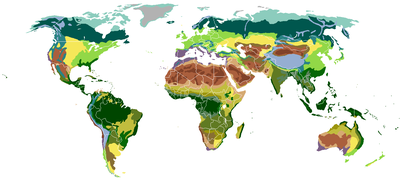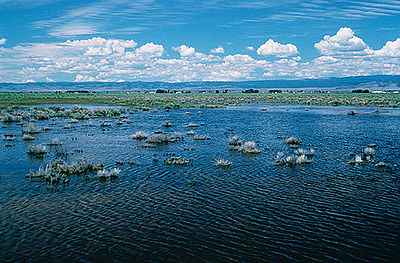Much of the work on vegetation classification comes from European and North American ecologists, and they have fundamentally different approaches. In North America, vegetation types are based on a combination of the following criteria: climate pattern, plant habit, phenology and/or growth form, and dominant species. In the current US standard (adopted by the Federal Geographic Data Committee (FGDC), and originally developed by UNESCO and The Nature Conservancy), the classification is hierarchical and incorporates the non-floristic criteria into the upper (most general) five levels and limited floristic criteria only into the lower (most specific) two levels. In Europe, classification often relies much more heavily, sometimes entirely, on floristic (species) composition alone, without explicit reference to climate, phenology or growth forms. It often emphasizes indicator or diagnostic species which separate one type from another.
In the FGDC standard, the hierarchy levels, from most general to most specific, are: system, class, subclass, group, formation, alliance, and association. The lowest level, or association, is thus the most precisely defined, and incorporates the names of the dominant one to three (usually two) species of the type. An example of a vegetation type defined at the level of class might be "Forest, canopy cover > 60%"; at the level of a formation as "Winter-rain, broad-leaved, evergreen, sclerophyllous, closed-canopy forest"; at the level of alliance as "Arbutus menziesii forest"; and at the level of association as "Arbutus menziesii-Lithocarpus densiflora forest", referring to Pacific madrone-tanoak forests which occur in California and Oregon, USA. In practice, the levels of the alliance and/or association are the most often used, particularly in vegetation mapping, just as the Latin binomial is most often used in discussing particular species in taxonomy and in general communication.
Victoria in Australia classifies its vegetation by Ecological Vegetation Class.
STRUCTURE
A primary characteristic of vegetation is its three-dimensional structure, sometimes referred to as its physiognomy, or architecture. Most people have an understanding of this idea through their familiarity with terms like "jungle", "woods", "prairie" or "meadow"; these terms conjure up a mental image of what such vegetation looks like. So, meadows are grassy and open, tropical rainforests are dense, tall and dark, savannas have trees dotting a grass-covered landscape, etc.
Obviously, a forest has a very different structure than a desert or a backyard lawn. Vegetation ecologists discriminate structure at much more detailed levels than this, but the principle is the same. Thus, different types of forests can have very different structures; tropical rainforests are very different from boreal conifer forests, both of which differ from temperate deciduous forests. Native grasslands in South Dakota, Arizona, and Indiana are visibly different from each other, low elevation chaparral differs from that at high elevations, etc.
Structure is determined by an interacting combination of environmental and historical factors, and species composition. It is characterized primarily by the horizontal and vertical distributions of plant biomass, particularly foliage biomass. Horizontal distributions refer to the pattern of spacing of plant stems on the ground. Plants can be very uniformly spaced, as in a tree plantation, or very non-uniformly spaced, as in many forests in rocky, mountainous terrain, where areas of high and low tree density alternate depending on the spatial pattern of soil and climatic variables. Three broad categories of spacing are recognized: uniform, random and clumped. These correspond directly to the expected variation in the distance between randomly chosen locations and the closest plant to such locations. Vertical distributions of biomass are determined by the inherent productivity of an area, the height potential of the dominant species, and the presence/absence of shade tolerant species in the flora. Communities with high productivities and in which at least one shade tolerant tree species is present, have high levels of biomass because of their high foliage densities throughout a large vertical distance.
Although this discussion centers on biomass, it is difficult to measure in practice. Ecologists thus often measure a surrogate, plantcover, which is defined as the percentage of the ground surface area that has plant biomass (especially foliage) vertically above it. If the vertical distribution of the foliage is broken into defined height layers, cover can be estimated for each layer, and the total cover value can therefore be over 100; otherwise the values range from zero to 100. The measure is designed to be a rough, but useful, approximation of biomass.
In some vegetation types, the underground distribution of biomass can also discriminate different types. Thus a sod-forming grassland has a more continuous and connected root system, while a bunchgrass community's is much less so, with more open spaces between plants (though often not as drastic as the openings or spacings in the above-ground part of the community, since root systems are generally less constrained in their horizontal growth patterns than are shoots). However, below-ground architecture is so much more time-consuming to measure, that vegetation structure is almost always described in relationship to the above-ground parts of the community.


No comments:
Post a Comment